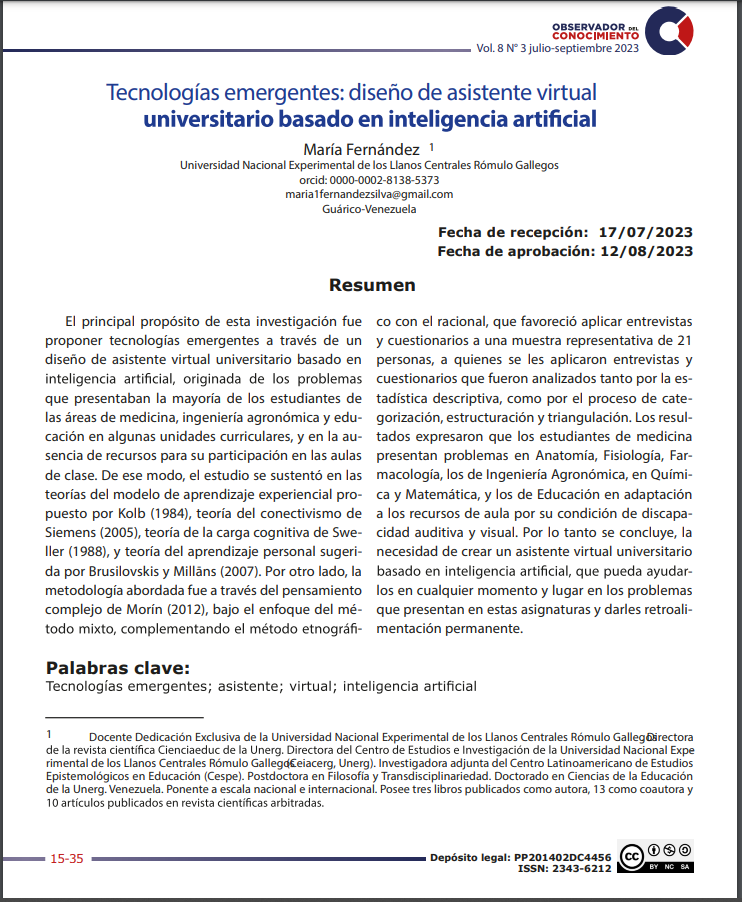Emerging Technologies: Artificial Intelligence-Based University Virtual Assistant Design
Keywords:
Technologies emerging, assistant, virtual, artificial intelligenceAbstract
This research had the general purpose of proposing emerging technologies: through a university virtual assistant design based on artificial intelligence, originated from the problems presented by the majority of students in the areas of medicine, agricultural engineering and education in some curricular units, and in the absence of resources for their participation in the classroom. In such a way that, this study was based on the theories of the experiential learning model proposed by Kolb (1984), the theory of connectivism by Siemens (2005), the theory of cognitive load proposed by Sweller (1988), and the theory of personal learning. Suggested by Brusilovskis and Millāns (2007). On the other hand, the methodology approached was through the complex thought of Morín (2012), under the mixed method approach, complementing the ethnographic method with the rational one, which favored applying both interviews and questionnaires to a representative sample of 21 people, to who were applied interviews and questionnaires that were analyzed both by descriptive statistics, and by the process of categorization, structuring and triangulation. The results expressed that medical students present problems in anatomy, physiology, pharmacology, engineering students in chemistry and mathematics, and education students in adaptation to classroom resources due to their hearing and visual disability. Therefore, it is concluded, the need to create a university virtual assistant based on artificial intelligence, which can help them at any time and place in the problems they present in these subjects and give them permanent feedback.
Downloads
References
Brusilovsky, P. y Peylo, C. (2003). Adaptive and intelligent web-based educational systems. International Journal of Artificial Intelligence in Education, 13(2-4), pp. 159-172.
Brusilovsky, P. & Millán, E. (2007). User models for adaptive hypermedia and adaptive educational systems. The Adaptive Web, 3-53.
Kolb, D. (1984). Experiential learning: Experience as the source of learning and development. Prentice-Hall.
Morín, E. (2012). Educar en la Era Planetaria. México Editorial Gedisa
Russell, S. y Norvig, P. (2010). Artificial Intelligence: A Modern Approach. Prentice Hall.
Siemens, G. (2005). Connectivism: A Learning Theory for the Digital Age. International Journal of Instructional Technology and Distance Learning, 2(1), pp. 3-10.
Sweller, J. (1988). Cognitive load during problem solving: Effects on learning. Cognitive Science, 12(2), 257-285.
VanLehn, K. (2006). The behavior of tutoring systems. International Journal of Artificial Intelligence in Education, 16(3), pp. 227-265.
Venkatesh, V. y Davis, F. (2000). A theoretical extension of the technology acceptance model: Four longitudinal field studies. Management Science, 46(2), pp. 186-204.
Wang, Y., Wang, J., Zhao, L., Huang, D. and Sun, M. (2016). A Survey on Chatbot Design Techniques in Speech Conversation Systems. Journal of Computer Science and Technology, 31(5), pp. 825-845.

Downloads
Published
How to Cite
Issue
Section
License

This work is licensed under a Creative Commons Attribution-NoDerivatives 4.0 International License.







